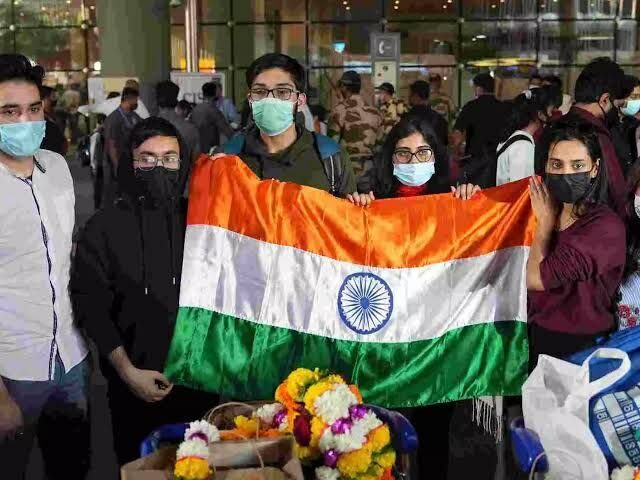EVACUATION STRATEGY AS A MATTER OF FOREIGN POLICY
WHY IN NEWS?
In the backdrop of Russia Ukraine war, the Government of India carried out a complex evacuation from the conflict hit Ukraine under the OPERATION GANGA to bring back thousands of stranded Indian nationals, particularly Indian students
EVACUATION STRATEGY
The strategy deployed in lifting people from danger place to a safer place is what is known as the evacuation strategy.
CIRCUMSTANCES WHICH CAN PUT PEOPLE’S LIFE IN DANGER
Partition
- Partition is one of the turmoil that can put the people’s life in
For Example, during partition of India in the year 1947, it was a chaotic situation as some wanted to join with the Indian union while the others needed to join with the Pakistan.
- This in turn necessitated the government of India to bring those who wanted to stay with the Indian union safely and provide them shelter and a livelihood
- Dangerous circumstances may appear not only when one’s own country underwent a divisional
problem but also when any other nation too.
2. Natural calamities
- Natural calamities like earth quake, floods etc will create a sense of danger to the lives of the
- In the year 2015, an earthquake had happened in India immediately went and rescued not only the Indian nationals but also the other foreign nationals stranded there.
3. War or accession
- When 2 countries indulge in a war or when one country tries to occupy the other, will create immense danger to the lives of people staying
4. Civilian revolution
- When people living in a particular territory revolt themselves against the existing ruler to bring a new regime, sometimes leading to a chaotic situation and will put the people’s life in danger
- Serious health crisis in the country like any pandemic or endemic g., Covid 19 pandemic
NEED FOR A PROPER EVACUATION STRATEGY
- Approximately around 14 million Indian expatriate workers and students are residing around 200 countries and they contribute to 3% of our Around$87-89 billion remittances are being received by India. Hence their economic contribution toward the Indian economy is very high.
- The political influence of these expatriates is high i.e.; these people influence the politics of some other countries
- The Diaspora population is growing day by day as the people starts moving to the different geographical areas, there by urges the need for a proper evacuation strategy
- The nature of conflicts also differs. some countries in the name of security wanted to expand their own sphere of influence, while on the other hand, civils revolts are happening in the name of democracy
IMPORTANCE OF A PROPER EVACUATIOON STRATEGY
- Evacuation process is important as it will protect its own nationals
- It is being considered as a real testing time for the government whether or not it is having a strong diplomatic skill
- It shows the strength of our soft power
- It shows India’s concerns about other nationals, e.g. During the Operation Rahat the Indian Armed Forces evacuated both Indian citizens as well as foreign nationals (including nationals from USA, Pakistan etc) from Yemen during the 2015 military intervention by Saudi Arabia and its allies in that country during the Yemeni Crisis which shows India’s concern about humanity
EVACUATION STRATEGIES OF INDIA
PARTIRION OF INDIA-1947
- During 1947, whenIndia got partitioned into the Indian union and the Pakistan union, lot of apprehensions were created in the minds of the people about which side of the border would they
- This in turn had created Unfortunately, the then India were not having a clear-cut mechanism to deal with that evacuation. The incident took lakhs of lives .
2. KUWAIT AIRLIFT 1990
- In one of the massive operations in Indian history, the Indian Air Force joined hands with Air India in airlifting stranded Indian nationals in Kuwait in August 1990. Nearly 170, 000 citizens were safely airlifted in this operation which was carried out just before the Persian Gulf war in
3. OPERATION SUKHOON -2006
- Operation Sukhoon was an operation launched by the Indian Navy to evacuate Indian, Sri Lankan and Nepalese nationals, as well as Lebanese nationals with Indian spouses, from the conflict zone during the 2006 Lebanon
- This operation is being considered as one of the Indian navy’s biggest rescue operations since World War 2.
4. OPERATION SAFE COMING 2011
- India launched ‘Operation Homecoming’ to bring back Indian citizens stranded in conflict-torn
- Under the operation, India evacuated 15,400 Indian nationals.
- The air-sea operation was conducted by the Indian Navy and Air
5. OPERATION MAITRI 2015
- It is the joint relief and rescue operation by the Indian government and the Indian Armed forces in the aftershock of the 2015 Nepal
- The joint Army-Air Force operation brought over 5,000 Indians back from Nepal by Air Force and civilian planes. The Indian army successfully evacuated 170 foreign nationals from the US, the UK, Russia and
6. OPERATION RAAHAT 2015
- In 2015, a conflict raged between the Yemeni government and Houthi rebels during which thousands of Indians were stranded and Yemen was not accessible by air due to a no-fly zone announced by Saudi
- Under Operation Rahat, India evacuated nearly 5,600 people from
7. VANDE BHARAT 2020
- When the Covid-19 pandemic hit the world, the Centre launched the Vande Bharat Mission to bring back Indian citizens stranded in foreign
- In the multiple phases of the operation, about 60 lakh Indians were brought back as on 30th April,
- Special flights were operated across to globe in this mission to bring back the nationals who were left stranded in foreign countries due to the coronavirus pandemic
8. OPERATION DEVI SHAKTI 2021
- An evacuation operation by the Indian Armed Forces (IAF) was kicked off in August 2021 to safely bring back Indian nationals from Afghanistan after the collapse of the Islamic Republic of Afghanistan and the fall of Kabul, the capital city of the Taliban
9. OPERATION GANGA 2022
- In a mission to evacuate stranded Indians from war-torn Ukraine, the Indian government kicked off Operation Ganga in February India has set up round the clock control centres in Poland,Romania, Hungary, Slovakia to assist in the evacuation of Indian nationals from Ukraine through border crossing points with these countries.
CHALLENGES TO THE EVACUATION STRATEGY
While India is not a newcomer to conducting evacuation operations, it has traditionally faced significant challenges in deploying its diplomatic and military assets abroad to protect its diaspora. The shortcomings of the government of India’s capacity have been further compounded by its nonaligned posture and consequent reluctance to get involved in conflict zones. However, as these operations become more frequent and complex, India will need to expand its operational capacity and prepare accordingly, including by adopting best practices from other states’ emergency plans. Evacuating citizens from abroad is an extremely complex mission in which distance, logistics, security, and coordination pose numerous obstacles.
1. Distance
- As the distance, where the intended evacuation to be done increases, more complex will be the evacuation
2. Logistics
- Pulling out thousands and lakhs of nationals from a foreign country in itself is a logistical nightmare because of the need to work out on the appropriate mode of transportation.
- The maximum duration the evacuation process lasts is also unknown e.g., evacuation process took almost 2 months during the gulf crisis. hence needs of the stranded nationals should be addressed
3. Coordination
- As the evacuation process in itself involves various processes, no single ministry can deal the entire evacuation process. Hence coordination among different ministries is required and that in itself is a hurdle since it is not recognised as a regular
4. Geographical spread of the people
- Expatriates residing in a particular country may not be residing in a single location. They may be distributed across that particular country. Hence it is a big challenge in locating the nationals and establishing a contact link between them, particularly those who are residing in the
5. Communication network
- Staying in constant touch with the stranded Indian nationals and ensuring their proper location is not an easy task. Hence embassy needs to maintain a list through which it can reach out to the Indians and thereby can stay in touch with them and can get updated about their
- Establishing a proper communication channel is considered as an important preparatory task to be done in such a dangerous condition especially when an evacuation strategy is planned
6. Number of evacuees
- As the number of evacuees increases, greater will be the evacuation challenge
7. Coordination from other countries
- Diplomatic contacts with neighbouring countries and theothers, keyleaders, institutions, rebel groups/terror outfits play a major during the evacuation missions to get the required permission as well as to ensure that a safe passage or humanitarian corridor is being created, so that the nationals can be pulled out.E.g.,during the Ukraine conflict, India didn’t lift the people directly from the Ukraine, instead relied on Poland,Hungary,Slovakia, Romania etc because of the difficulty in entering into the conflict zone
- but at times, some countries refuse to cooperate which poses hurdles in the evacuation
- Complex geopolitics of the complex zones should also be kept in mind in order to ensure that it
doesn’t offend any country or party unnecessarily which might hamper the evacuation activities
8. Attitude of the local government
- Support of the local government is a necessity during every evacuation mission e.g., during the Ukrainian crisis, Russia had stopped the war for around 5-6 hours in order to create a humanitarian corridor
- But at times, the local government might refuse to cooperate thereby will create a hindrance on the evacuation process
LONG TERM STRATEGY
In spite of all the mentionedchallenges, India had undertaken around 30 evacuation processes till now. Government of India rise to the occasion to the best possible extentin order to bring back all our nationals. Despite all those successful evacuation missions, India must devise a proper strategy under its foreign policy in such a way that it must not only deal with trade, immigration and emigration but should also include a separate department and a separate budget for dealing with the evacuation and safety of the Indian diaspora. Hence a long-term evacuation strategy is very important –
1. Learn From the Past
- Support policy-oriented research on India’s vast experience in conducting evacuation operations
- Document the institutional memory of senior diplomats and military and other government officials that have successfully conducted evacuation operations in recent years. Such efforts would help transmit their expertise and best practices to younger
- Reach out to key stakeholders, associations, and activists in the diaspora that participated in past evacuation By listening to their grievances and suggestions, the government can build on best practices and correct shortcomings
2. Develop Standard Operating Procedures
- Establish a clear chain of command and division of labour among various ministries, overseas missions, and other organizations
- Identify regional support bases, local assembling camps, and routes for
- Adopt country-specific warden systems to communicate with
- Sign standing service agreements with local companies providing emergency transportation and relief to avoid lack of supplies and inflated costs during
- Develop criteria regulating priority lists of evacuation and embarkation
3. Train, Prepare, and Collaborate
- Offer security training for all incoming Indian Foreign Service probationers on how to operate in active conflict zones, with support from the Indian Police Service or Indian
- Conduct evacuation operation simulations and periodic emergency
- Create rapid reaction teams of Indian military, police, and other security personnel that can be deployed as advisory missions to protect diplomatic staff and installations in hostile
- Encourage Indian diplomatic missions to intensify political and consular dialogue with their counterparts so as to exchange information and prepare joint emergency and evacuation
4. Involve and Deploy Military Forces
- Invest in specific training for military personnel to conduct out-of-area evacuation operations, including through joint exercises with other friendly military services that have greater experience in this domain.
- Adapt military modernization, defence procurement, and production plans to focus on acquiring specific assets that increase India’s long-range military transportation, naval, aerial, and
- Conclude bilateral defence agreements that guarantee the Indian Armed Forces continued access to military support bases in the Gulf and other critical regions to conduct evacuation
5. Improve Coordination
- Incentivize cross-posting of administrative and military officials dealing with diaspora affairs, including in the political and consular sections of diplomatic missions in countries with volatile security conditions.
- Facilitate the creation of diaspora emergency cells and contingency plans by regional state governments, following guidelines set out by central
Identify and Monitor the Diaspora
- Utilize new communication technologies to provide both permanent expatriates and short-term travellers with real-time updates during crises and evacuation
- Continue to crack down on agents and other intermediaries that facilitate the illegal migration of low- skilled and illiterate Indian workers, whose vulnerability during crises poses a significant security liability
- Sustain investment in pre-departure training of low-skilled workers, informing them of basic rights and security procedures to follow in case of emergency and
- Consider making the Aadhaar unique identification card compulsory for Indian citizens abroad to facilitate biometric identity verification and reduce identity
CONCLUSION
To protect its migrants and travellers more effectively, the Indian government needs to dedicate significant resources toward building on best practices from the past, developing standard operating procedures, expanding training and preparedness, institutionalizing emergency evacuation plans, and increasing coordination with other states. By enhancing its capacity to conduct evacuation operations and ensure the safety of its citizens abroad, the Indian government will not only be pursuing its immediate national interests but will also be able to credibly project power and assume a leading role beyond its sub continental shores.
PRACTICE QUESTION
India’s expatriates’ evacuation strategy requires a shift from adhocism to a permanent policy, critically comment in the context of growing global uncertainties. (250 words, 15 marks)










